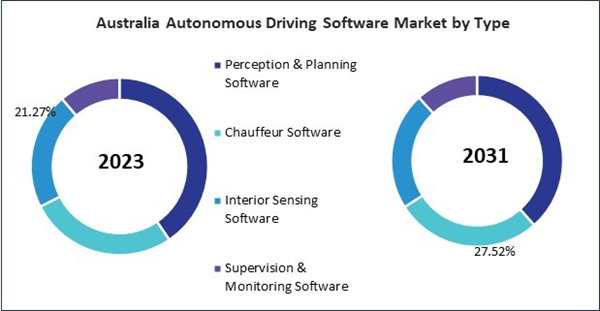The China market dominated the Asia Pacific Autonomous Driving Software Market by Country in 2023, and would continue to be a dominant market till 2031; thereby, achieving a market value of $349.7 million by 2031. The Japan market is registering a CAGR of 13.2% during (2024 - 2031). Additionally, The India market would showcase a CAGR of 14.6% during (2024 - 2031).
Governments and private companies are forming partnerships to advance autonomous driving technology. These collaborations often involve joint research projects, shared testing facilities, and co-development of regulatory frameworks, helping to align industry goals with public interests. Companies are gradually adopting incremental deployment strategies to introduce autonomous vehicles to the market. This approach involves rolling out technology in specific use cases or geographic areas before expanding to broader applications, allowing for iterative improvements and stakeholder feedback.
As autonomous driving technology becomes more prevalent, educating consumers about its benefits and limitations is crucial. Companies invest in public awareness campaigns, demonstrations, and interactive experiences to build trust and understanding around autonomous vehicles. The adoption of autonomous driving software is facilitated by efforts to integrate these technologies with existing transportation infrastructure. This includes upgrading traffic signals, road signs, and communication networks to support autonomous vehicle operations and enhance overall system compatibility.
Increased government funding and subsidies for research and development in autonomous driving technologies have attracted additional investments from both domestic and international stakeholders. Under the RoAD to the L4 project, several initiatives are being planned and executed in different locations. For example, Japan's first lanes dedicated to autonomous vehicles are being set up on a public road in Hitachi City. The government plans to expand these autonomous driving lanes to fifty locations by 2025 to help solve the shortage of bus drivers. To facilitate the advancement of ADS development, the government has promoted public-private partnerships, which seek to cultivate collaboration among automotive manufacturers, technology companies, and research institutions. Thus, the rising investments and increasing efforts for autonomous vehicles in the region drive the market's growth.
Based on Propulsion, the market is segmented into ICE and Electric Vehicles. Based on Level of Autonomy, the market is segmented into L2, L1, L3, and L4 & L5. Based on Vehicle Type, the market is segmented into Passenger Vehicles and Commercial Vehicles. Based on Type, the market is segmented into Perception & Planning Software, Chauffeur Software, Interior Sensing Software, and Supervision & Monitoring Software. Based on countries, the market is segmented into China, Japan, India, South Korea, Australia, Malaysia, and Rest of Asia Pacific.
List of Key Companies Profiled
- Aptiv PLC
- Baidu, Inc.
- Continental AG
- Huawei Technologies Co., Ltd. (Huawei Investment & Holding Co., Ltd.)
- Intel Corporation
- NVIDIA Corporation
- Forvia SE
- Qualcomm Incorporated (Qualcomm Technologies, Inc.)
- Robert Bosch GmbH
- Mercedes-Benz Group AG
Market Report Segmentation
By Propulsion
- ICE
- Electric Vehicles
By Level of Autonomy
- L2
- L1
- L3
- L4 & L5
By Vehicle Type
- Passenger Vehicles
- Commercial Vehicles
By Type
- Perception & Planning Software
- Chauffeur Software
- Interior Sensing Software
- Supervision & Monitoring Software
By Country
- China
- Japan
- India
- South Korea
- Singapore
- Malaysia
- Rest of Asia Pacific
Table of Contents
Companies Mentioned
- Aptiv PLC
- Baidu, Inc.
- Continental AG
- Huawei Technologies Co., Ltd. (Huawei Investment & Holding Co., Ltd.)
- Intel Corporation
- NVIDIA Corporation
- Forvia SE
- Qualcomm Incorporated (Qualcomm Technologies, Inc.)
- Robert Bosch GmbH
- Mercedes-Benz Group AG
Methodology

LOADING...









